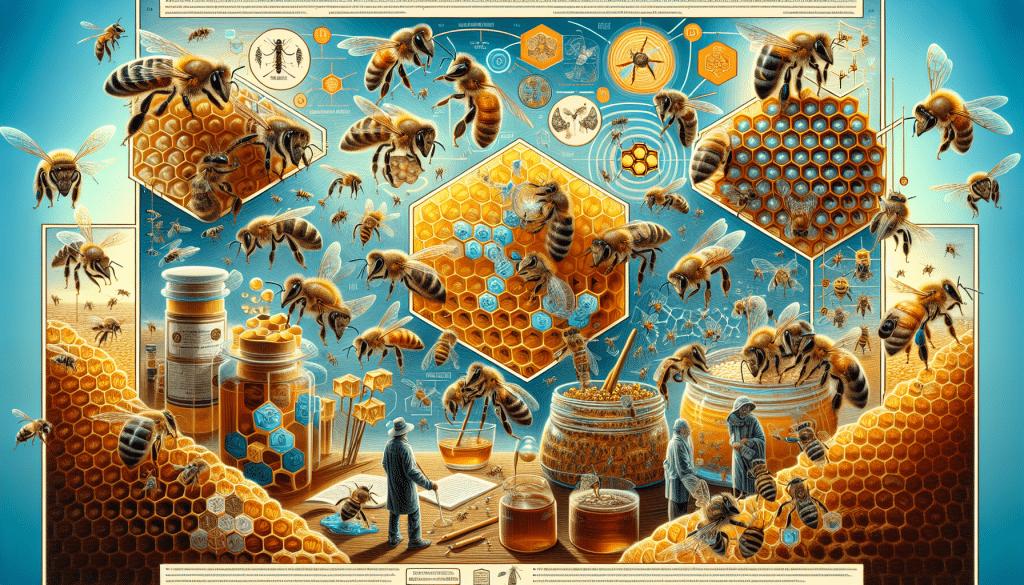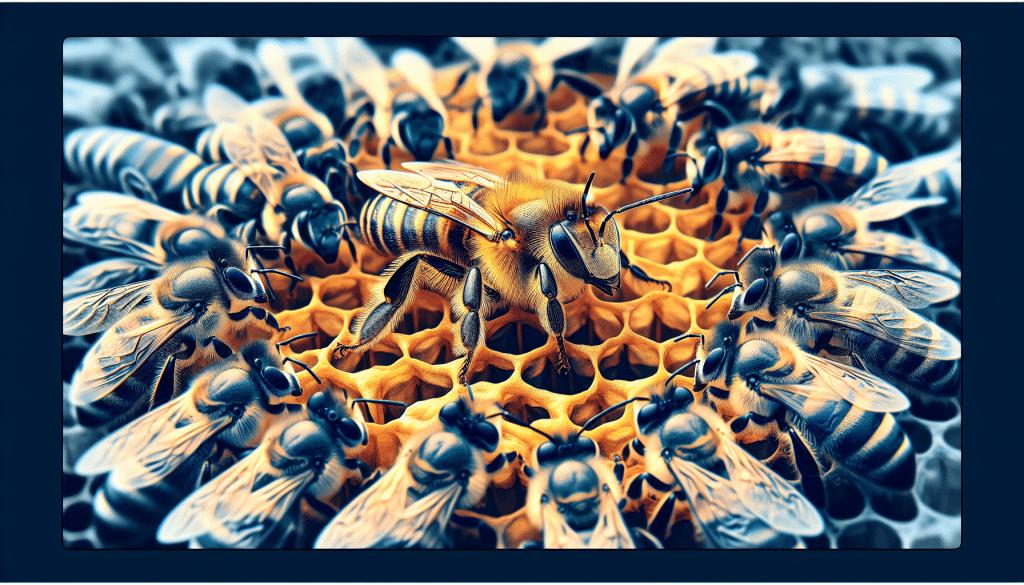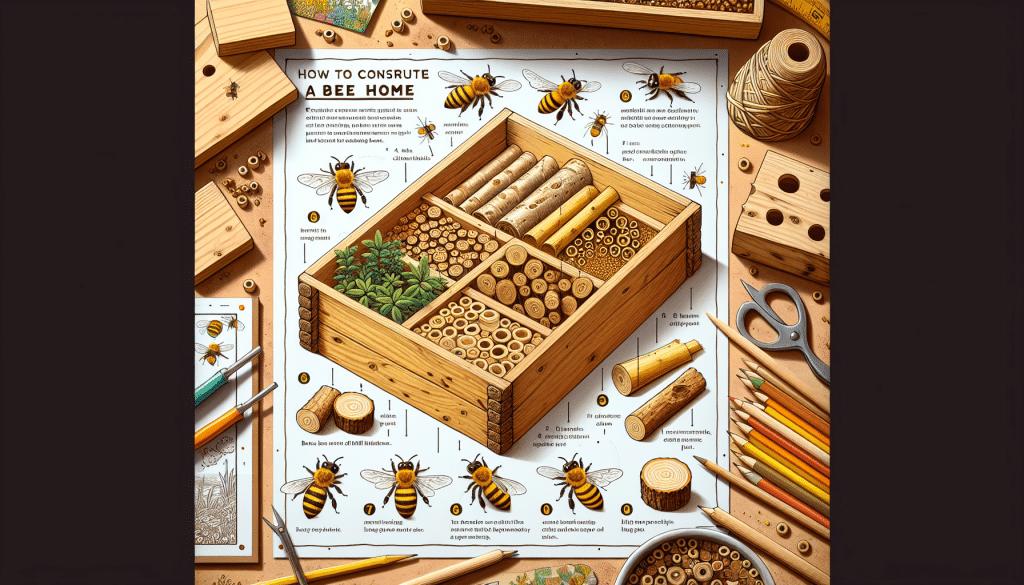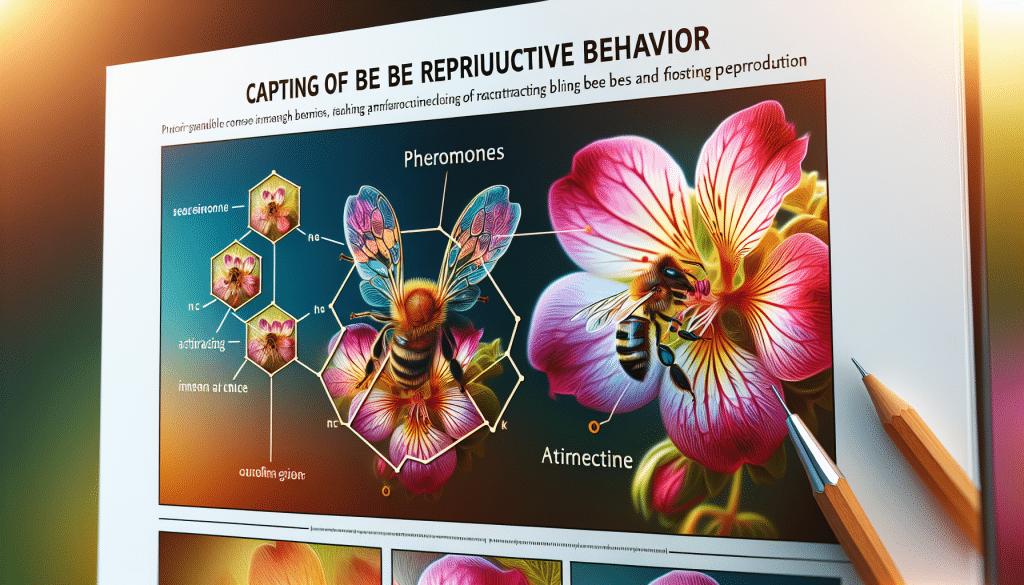So, you’ve found yourself drawn into the fascinating world of bee behavior, huh? Well, brace yourself for a wild ride! In this article, we’ll take you on a journey through the quirky and sometimes downright hilarious antics of these honey-making daredevils. From their intricate dances to their knack for disguising themselves as miniature “flowers,” you’ll be amazed at just how much these tiny insects can teach us about communication and teamwork. So grab your beekeeper suit and get ready to laugh your way to a newfound appreciation for these buzzing creatures!
The Social Structure of Bee Colonies

Understanding the Queen’s Role
In the social hierarchy of a bee colony, the queen bee reigns supreme. She is the matriarch and the primary reproducer of the colony. Her main duty is to lay eggs to ensure the survival and growth of the colony. The queen is larger than the worker bees and has a distinctive long abdomen. She emits pheromones that regulate the behavior and development of the other bees in the colony. Without a queen, a bee colony cannot thrive or reproduce.
The Duties of Worker Bees
Worker bees, which are all female, form the majority of the bee colony. They are responsible for various tasks necessary for the survival of the colony. They build and maintain the hive, collect nectar and pollen, feed the queen and larvae, guard the hive, and forage for resources. Worker bees are highly organized and communicate with each other to ensure the smooth running of the colony.
The Life of Drones
Drones, on the other hand, are male bees whose sole purpose is to mate with the queen. They do not have stingers and cannot collect nectar or pollen. Drones have larger eyes than worker bees and are slightly bigger in size. However, their lives are short-lived. Once they mate with the queen, they die, as their purpose has been fulfilled. While drones might seem like slackers in the grand scheme of things, they play a crucial role in continuing the genetic diversity of the colony.
Division of Labor Among Workers
Within the worker bee population, there is a clear division of labor. Young worker bees are responsible for tasks such as cleaning and nursing the larvae, while older workers take on more demanding duties like foraging and guarding the hive. This division ensures efficient use of resources and optimal functioning of the colony. Workers also transition from one task to another based on the needs of the colony, showing their resilience and adaptability.
Communication among Bees
Waggle Dance and Its Significance
One of the most fascinating forms of communication among bees is the waggle dance. Honeybees use this dance to convey valuable information about the direction and distance of food sources to their fellow workers. By waggling their bodies in a specific pattern and direction, bees can indicate the precise location of nectar-filled flowers or water sources. It’s like the bee version of “Hey, folks, dinner’s over there!”
Pheromones and Chemical Communication
Bees are masters of chemical communication. They produce and release pheromones to transmit information about various aspects of colony life. For instance, the queen bee releases a pheromone known as the queen substance to signal her presence and maintain social cohesion within the colony. Pheromones also play a role in signaling alarm, attraction, and identifying members of the same colony. It’s like the bees’ own secret language that keeps everything running smoothly.
Vibrations as a Means of Communication
Bees communicate through vibrations as well. By producing specific vibrations or buzzing sounds, they can convey messages to their fellow colony members. For example, during the swarming process, the vibrating buzzing sound signals that it’s time to move to a new location. Bees also use vibrations to communicate about food availability or imminent danger. It’s their way of saying, “Listen up, everyone, something important is happening!”
The Role of Touch and Trophallaxis
Trophallaxis may sound complicated, but it’s just a fancy word for the sharing of food between bees. This act involves the exchange of regurgitated nectar and other food substances among hive members. Trophallaxis serves multiple purposes, including the distribution of nutrients, sharing information about available resources, and strengthening social bonds within the colony. It’s like the communal dinner table where everyone gets a taste and stays connected.
Foraging Behavior
Flower Selection and Preference
Bees are selective when it comes to their floral choices. They have preferences for certain types of flowers based on factors such as color, odor, nectar availability, and ease of access. Bees are particularly drawn to flowers with bright colors, sweet scents, and high levels of nectar. By selectively foraging on specific flowers, they play a crucial role in pollination, ensuring the reproduction of flowering plants.
Navigational Skills and Spatial Awareness
Bees possess impressive navigational skills. They use various cues, including the position of the sun, landmarks, and polarized light, to navigate their surroundings and find their way back to the hive. Bees are known to perform intricate flight patterns called “orientation flights” near the hive to familiarize themselves with the surrounding area. This spatial awareness allows them to efficiently locate food sources and return to the hive to communicate their findings.
Role of Memory in Foraging
Bees have an exceptional ability to remember and recognize specific locations, including their favorite nectar sources. They can remember the location of blooming flowers, water sources, and even the layout of landmarks in their foraging area. This memory enables bees to optimize their foraging routes and maximize their energy expenditure, ensuring a steady supply of resources for the colony.
Adapting to Environmental Changes
Bees are incredibly adaptable and can adjust their foraging behavior in response to environmental changes. They are adept at detecting changes in resource availability and can quickly switch to alternative food sources when needed. For example, during periods of drought or scarcity, they may explore new areas or shift their preferences to find alternative nectar sources. This adaptability ensures the survival of the colony, even in challenging environmental conditions.
Reproductive Behavior

Mating Habits of the Queen
The queen bee’s mating habits are a critical aspect of colony reproduction. During her mating flight, the queen mates with multiple drones from different colonies, ensuring genetic diversity within the offspring. Once the queen mates, she stores the sperm in her body, which she will use to fertilize eggs throughout her life. This extraordinary ability allows the queen to control the genetic makeup of the colony.
The Swarm: Colony Reproduction
When a colony becomes overcrowded due to a high population, a fascinating phenomenon known as swarming occurs. Swarming is the process where a group of worker bees, led by a new queen bee, leaves the existing hive to establish a new colony. Swarming ensures the survival and expansion of the species by spreading bees to new locations. It’s like the bees’ version of “moving out of your parents’ basement” to start a new life.
Male Bee Competition and the Mating Flight
Competition among male bees, or drones, is intense when it comes to mating with a queen. Drones compete fiercely for the opportunity to mate, engaging in mid-air battles to assert dominance. Only a few lucky drones will successfully mate with the queen during her mating flight, while the unsuccessful ones return to the colony empty-handed. It’s a high-stakes game of love and reproduction in the bee world.
Establishing New Colonies
When a swarm leaves the hive, the bees search for a suitable location to establish a new colony. They scout for cavities, trees, or man-made structures that provide protection and sufficient space for future growth. Once a suitable location is found, the worker bees start building a new hive, and the queen starts laying eggs to rebuild the colony’s population. This process ensures the continuation of the bee community and the expansion of their influence.
Defense Mechanisms
Stinging as a Defensive Act
Everybody knows that bees sting, and they do so as a defensive mechanism. Worker bees have a stinger attached to their abdomen, which they use to defend the hive against threats. When a bee stings, it injects venom into the attacker, causing pain and deterring further aggression. However, the act of stinging comes at a high cost to the bee, as it loses its stinger and ultimately dies. It’s the ultimate sacrifice for the greater good of the colony.
Roles in Hive Defense
Apart from stinging, bees have other roles in hive defense. Guard bees station themselves at the entrance of the hive, monitoring any incoming or outgoing bees for signs of danger. If an intruder is detected, the guard bees release alarm pheromones to alert the rest of the colony. Worker bees can also form a “bee ball” around an intruder, effectively suffocating it with heat and carbon dioxide. Bees are not to be messed with when it comes to protecting their home.
Guarding Behavior and Intruder Recognition
Guarding behavior is crucial for the security of the hive. Bees can recognize and differentiate between colony members and intruders by their unique pheromone signatures. Any foreign scent triggers defensive responses, prompting the guard bees to take action. Identifying and neutralizing potential threats helps maintain the safety and integrity of the colony.
Collective Defense Patterns
When the hive is under attack, bees exhibit collective defense patterns. They come together as a coordinated unit, working in harmony to repel invaders. By mobbing and overpowering predators or other threats, bees demonstrate the strength in numbers. It’s like a miniature army defending their fortress, with each bee playing a specific role in the collective defense of their colony.
Seasonal Behavior Changes
Winter Clustering to Preserve Heat
During winter, when temperatures drop, bees engage in a behavior known as clustering. They form a tight cluster within the hive, surrounding the queen and shivering their wing muscles to generate heat. The bees take turns rotating from the inside to the outside of the cluster, ensuring everyone stays warm. This cluster acts as a winter survival strategy, allowing the colony to maintain a stable temperature and conserve energy until spring arrives.
Spring Buildup and Pollination
With the arrival of spring, bees shift their focus to the expansion and growth of the colony. The queen increases her egg-laying rate, and worker bees gather nectar and pollen to feed the growing population. This influx of food resources allows the colony to thrive and build up its numbers. Furthermore, as bees collect pollen, they inadvertently participate in the vital process of pollination, playing a crucial role in the reproduction of flowering plants.
Summer Activities and Population Boom
Summer is a busy season for bees, as resources are abundant and the weather is favorable. The colony population booms, reaching its peak during this time. Worker bees forage tirelessly, collecting nectar, pollen, and water to sustain the growing population. Additionally, bees engage in tasks such as wax production, comb building, and hive maintenance. It’s a season of bustling activity and growth for the bee community.
Autumn Preparations for Winter
As autumn approaches, bees shift their focus once again to preparing for the colder months ahead. They start conserving resources and reducing the colony’s population. Bees seal unused hive cells with wax, creating storage for honey and pollen to sustain them during winter. The queen’s egg-laying rate decreases, ensuring a smaller population to manage and feed. This preparation ensures the survival and endurance of the colony through the challenging winter season.
Bee Nutrition and Feeding Habits

Pollen and Nectar Collection
Bees rely on two primary food sources: pollen and nectar. Pollen is a rich source of protein that provides the necessary nutrients for bee development. Worker bees collect pollen by scraping it off flowers using specialized body hairs and arranging it into pellets to transport back to the hive. Nectar, on the other hand, is a sugary liquid found in the base of flowers. Bees use their long tongues to lap up the nectar and store it in their honey stomachs for transportation back to the hive.
Importance of Water for Bees
Water is essential for the survival of bees, particularly during hot and dry conditions. Bees require water to regulate the temperature within the hive and dilute honey for consumption. They also need water for hydration and to maintain the ideal humidity levels within the hive. Bees collect water from various sources, such as puddles, rivers, or even condensation on leaves. Providing a water source in the proximity of bee colonies is crucial for their well-being.
Feeding Larvae and Royal Jelly Production
Worker bees play a critical role in feeding the colony’s larvae. They regurgitate the stored nectar and mix it with enzymes to produce a nutritious substance called royal jelly. Royal jelly is a superfood for the bee larvae, ensuring their optimal growth and development. In addition to feeding the larvae, worker bees also produce royal jelly to feed the queen, contributing to her superior size and fertility.
Dietary Needs and Food Storage
Bees have specific dietary needs to maintain their health. They require a balanced diet of carbohydrates, proteins, lipids, vitamins, and minerals. By collecting nectar and pollen from different flowers, bees ensure they have a diverse range of nutrients available. Bees also store excess food, such as honey and pollen, within the hive for times of scarcity or winter survival. This strategic food storage ensures the availability of resources during periods when foraging is challenging.
Bee Learning and Cognition
Learning Through Trial and Error
Bees are capable learners, and they learn through trial and error. When foraging, bees learn which flowers provide the best nectar rewards and remember their locations for future visits. They remember which scents or colors indicate a rich food source and adjust their foraging preferences accordingly. This trial and error learning helps bees optimize their foraging efficiency and improve their overall success rate.
Cognitive Mapping and Navigation
Bees possess astonishing cognitive mapping abilities. They create a mental map of their environment, which helps them navigate to specific locations and return to the hive accurately. Bees use landmarks, celestial cues, and polarized light patterns to create this internal map. By employing these cognitive skills, bees can forage efficiently over large areas and communicate the location of valuable resources to their colony members.
Pattern Recognition Abilities
Bees have an impressive ability to recognize and remember patterns. They can distinguish between different shapes, colors, and scents, allowing them to identify specific flower types and learn the association between a rewarding flower and its unique characteristics. This pattern recognition capability enables bees to quickly locate and access the most rewarding flowers during their foraging trips.
Time-Sensing and Sun Compass Use
Bees have an internal sense of time and can use the sun as a compass for navigation. They can sense changes in the sun’s position throughout the day and adjust their flight paths accordingly. Bees use this innate sun compass to determine the most efficient routes between the hive and food sources. They can also compensate for the movement of the sun, accounting for its changing position throughout the day.
Hive Construction and Maintenance
Wax Production and Comb Building
Worker bees are skilled architects and builders. They produce wax by consuming sugar-rich honey and convert it into beeswax. Beeswax is used to construct honeycomb-like structures called cells. The hexagonal shape of the cells maximizes space efficiency while providing support for storing brood, honey, pollen, and royal jelly. The meticulous comb building ensures the structural integrity of the hive and facilitates efficient communication within the colony.
Temperature Regulation in the Hive
Bees are masters of temperature regulation. They maintain a relatively constant temperature within the hive, regardless of the external environment. Worker bees generate heat by contracting their wing muscles, while others spread their wings to dissipate excess heat. By coordinating these activities, bees keep the hive at an optimal temperature, ensuring the survival of brood and the efficient functioning of other hive processes.
Hive Cleanliness and Disease Prevention
Bees are diligent in maintaining a clean and hygienic hive environment. They remove debris, dead bees, and other waste materials from the hive to prevent the spread of diseases. Bees groom each other, removing parasites and pathogens that may be present on their bodies. Additionally, bees produce antimicrobial substances like propolis to further protect the hive against pathogens. Good hygiene is essential for the overall health and well-being of the colony.
Expansion and Swarm Preparation
When a colony grows too large for its current hive, bees engage in hive expansion and swarm preparation. Worker bees construct additional cells and enlarge the hive to accommodate the increasing population. At the same time, the colony prepares for swarming, a natural process to establish a new colony. The preparation involves selecting a new queen, storing ample resources for the swarm, and scouting for suitable locations for the swarm to begin anew.
Human Impact on Bee Behavior
Effects of Pesticides on Bee Colonies
The use of pesticides in modern agriculture has had detrimental effects on bee colonies. Pesticides, particularly neonicotinoids, can impair bees’ foraging abilities, navigation skills, learning capacity, and overall health. Exposure to these chemicals can lead to colony decline, decreased reproduction, and increased susceptibility to diseases. It’s essential to adopt sustainable agricultural practices and minimize pesticide usage to protect the well-being of our bee populations.
Urbanization and Loss of Foraging Grounds
As urban areas expand, natural habitats and foraging grounds for bees are being lost. The conversion of green spaces into concrete jungles deprives bees of crucial food sources and nesting sites. Urbanization also exposes bees to pollution, increased pesticide usage in gardens, and decreased biodiversity. Implementing urban beekeeping initiatives and creating bee-friendly habitats in cities can help mitigate the negative impact of urbanization on bee behavior.
Conservation Efforts and Beekeeping Practices
Awareness about the importance of bees in our ecosystem has led to increased conservation efforts and beekeeping practices. Organizations and individuals are taking initiatives to create bee-friendly environments, plant pollinator-friendly gardens, and preserve natural habitats. Beekeepers play a vital role in maintaining bee populations, ensuring their well-being, and contributing to pollination efforts. By adopting sustainable beekeeping practices, we can support healthy bee populations and enhance their behavior.
Climate Change and its Influence on Bees
Climate change poses significant challenges to bee behavior. Rising temperatures and unpredictable weather patterns can disrupt bee foraging schedules, affect floral bloom times, and reduce the availability of resources. Changes in precipitation patterns and extreme weather events can also impact the availability and quality of food sources. Adapting agricultural practices and implementing measures to mitigate climate change can help safeguard bee populations and their behavior.
Understanding bee behavior through observation provides a glimpse into the intricate social structure and remarkable abilities of these fascinating creatures. The queen’s role, the division of labor among worker bees, and the life and purpose of drones all contribute to the successful functioning of a bee colony. Communication methods like the waggle dance, chemical signals, vibrations, and touch play crucial roles in maintaining social cohesion. Foraging behavior, reproductive habits, defense mechanisms, and seasonal adaptations all highlight the remarkable adaptations of bees to their environment. Their nutritional needs, learning abilities, hive construction, and vulnerability to human impact further emphasize the importance of understanding and conserving bee behavior. By unraveling the intricacies of bee behavior, we can appreciate the incredible world of these industrious and essential pollinators.



